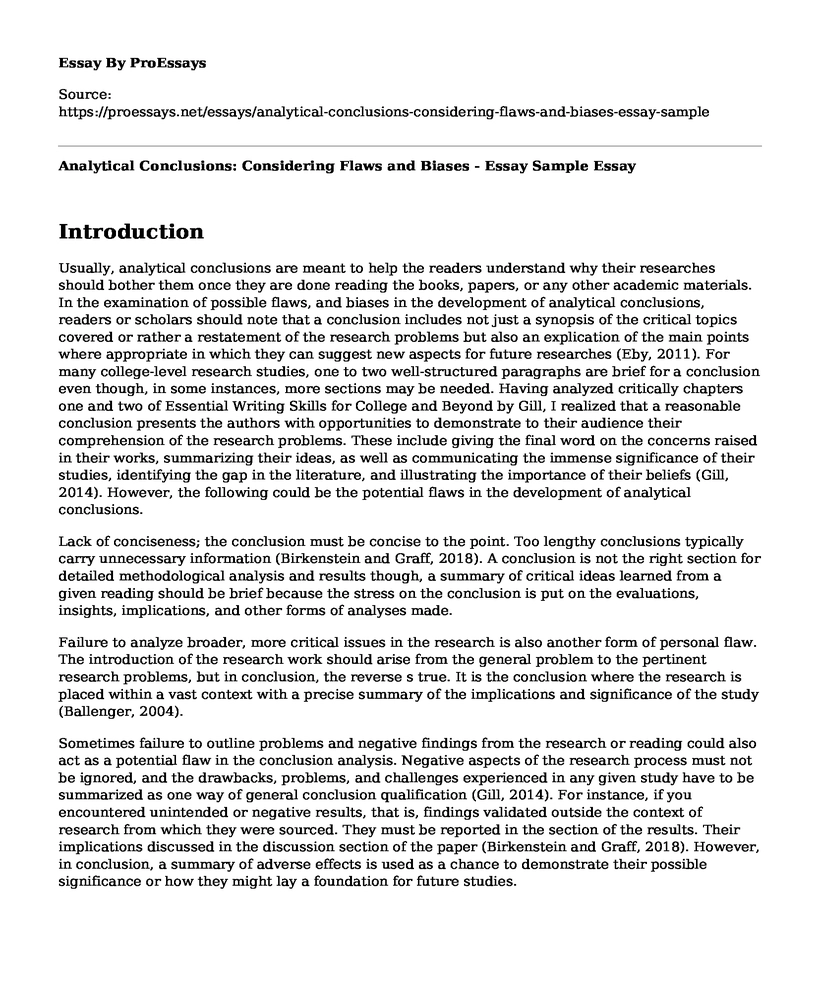Introduction
Usually, analytical conclusions are meant to help the readers understand why their researches should bother them once they are done reading the books, papers, or any other academic materials. In the examination of possible flaws, and biases in the development of analytical conclusions, readers or scholars should note that a conclusion includes not just a synopsis of the critical topics covered or rather a restatement of the research problems but also an explication of the main points where appropriate in which they can suggest new aspects for future researches (Eby, 2011). For many college-level research studies, one to two well-structured paragraphs are brief for a conclusion even though, in some instances, more sections may be needed. Having analyzed critically chapters one and two of Essential Writing Skills for College and Beyond by Gill, I realized that a reasonable conclusion presents the authors with opportunities to demonstrate to their audience their comprehension of the research problems. These include giving the final word on the concerns raised in their works, summarizing their ideas, as well as communicating the immense significance of their studies, identifying the gap in the literature, and illustrating the importance of their beliefs (Gill, 2014). However, the following could be the potential flaws in the development of analytical conclusions.
Lack of conciseness; the conclusion must be concise to the point. Too lengthy conclusions typically carry unnecessary information (Birkenstein and Graff, 2018). A conclusion is not the right section for detailed methodological analysis and results though, a summary of critical ideas learned from a given reading should be brief because the stress on the conclusion is put on the evaluations, insights, implications, and other forms of analyses made.
Failure to analyze broader, more critical issues in the research is also another form of personal flaw. The introduction of the research work should arise from the general problem to the pertinent research problems, but in conclusion, the reverse s true. It is the conclusion where the research is placed within a vast context with a precise summary of the implications and significance of the study (Ballenger, 2004).
Sometimes failure to outline problems and negative findings from the research or reading could also act as a potential flaw in the conclusion analysis. Negative aspects of the research process must not be ignored, and the drawbacks, problems, and challenges experienced in any given study have to be summarized as one way of general conclusion qualification (Gill, 2014). For instance, if you encountered unintended or negative results, that is, findings validated outside the context of research from which they were sourced. They must be reported in the section of the results. Their implications discussed in the discussion section of the paper (Birkenstein and Graff, 2018). However, in conclusion, a summary of adverse effects is used as a chance to demonstrate their possible significance or how they might lay a foundation for future studies.
Conclusion
It is significant to unequivocally accept that conclusions from the research and analysis outcomes are not triggered by bias, and it is neither the central role of an analyst in question but is instead a shared responsibility of all who are directly involved in coming to a correct verdict based on the appropriate data. For instance, in the marketing world where analysis and data have an increasingly considerable part, one should rely on valid facts taking into account that a point cannot be a fact until proven.
References
Badke, W. (2017). Research strategies: Finding your way through the information fog. iUniverse. doi.org/10.1002/bult.2011.1720380111
Ballenger, B. P. (2004). The curious researcher: A guide to writing research papers. Pearson/Longman.
Birkenstein, C., & Graff, G. (2018). They Say/I Say The Moves That Matter in Academic Writing. WW Norton & Company.
Eby, E. (2011). The College Student's Guide to Writing a Great Research Paper: 101 Easy Tips & Tricks to Make Your Work Stand Out. Atlantic Publishing Company.
Gill, C. (2014). Essential Writing Skills for College and Beyond. Penguin.
Cite this page
Analytical Conclusions: Considering Flaws and Biases - Essay Sample. (2023, Aug 22). Retrieved from https://proessays.net/essays/analytical-conclusions-considering-flaws-and-biases-essay-sample
If you are the original author of this essay and no longer wish to have it published on the ProEssays website, please click below to request its removal:
- Cause of Police Reforms in Mexico
- Essay Sample on The Uniform Crime Report (UCR)
- Essay Example on Global Exploitation of Migrant Workers: Historical Overview
- Research Paper on Nigeria: Poverty Rate on the Rise
- Domestic Violence: A Leading Health Problem in the U.S. - Essay Sample
- Women, Abuse, and Suicide: Investigating the Links - Essay Sample
- Addiction: A Disease Affecting Behaviour and Brain - Essay Sample







